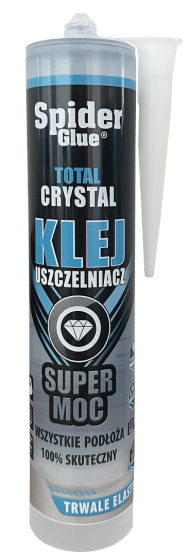Montage Adhesive Spider Glue Total Crystal
Bonding:
e.g. glass, glass-wood, mineral-acrylic composite, quartz conglomerate, concrete, brick, clinker, OSB, MDF and HDF boards, chipboards and glued boards, plywood, MFP and laminated boards, decorative and structural wood, iron, aluminum, galvanized sheet metal, steel, stainless steel and other metals, ceramic tiles, stoneware, cork.
Fixing:
e.g. skirting boards made of MDF, polyurethane, aluminum, stainless steel, PVC and wood, window sills, stairs, door thresholds, roof edges, structural panels, insulating materials, plasterboards, polystyrene decorations and decorative frames.
Sealing:
e.g. window sills, door thresholds, skirting boards, window frames, stair steps, etc.
Also suitable for sealing cracks in walls and ceilings.
Bonding of PMMA, PC, PP, PE or Teflon only after carrying out a compatibility and adhesion test.
*It is not recommended as a glass sealant and is not intended for gluing aquariums.
APPLICATION EXAMPLES / INDUSTRIES
› Assembly gluing and sealing;
› Furniture industry;
› Stonemasonry plants and products;
› Construction and repair of special vehicles, trailers and caravans;
› Solar and wind power plants;
› Window and door construction;
› Construction of devices and installations;
› Various industrial sectors;
› Advertising industry
› Flexible, transparent adhesive connection;
› Crystal clear after curing;
› Free of silicones, acids, bases and isocyanates;
› Slight shrinkage;
› Extremely fast setting time;
› Compensates for the expansion of various materials;
› Good resistance to weather conditions;
› Good resistance to UV radiation;
› Suitable for painting (wet on wet) and sanding;
› Resistant to chemicals including: aliphatic solvents, ketones, alcohols, esters, diluted acids and bases, and salt water;
› When gluing elements to substrates made of mineral plaster, fiber cement, old concrete or limestone masonry, it is recommended to use a deep penetrating primer.
Colour crystalline/transparent
Working temperature from 0°C to +40°C
State of matter sticky paste
Curing mechanism moisture from the air
Skin formation time 12-15 min. (23°C, RH 50%)
Curing speed 2 mm/24 h (23°C, RH 50%)
Relative density 1,05 ±0,02 g/m3
Hardened joint
Hardness (Shore A) 45±3
Elongation at break >250%
Module of elasticity 1,2 N/mm2
Thermal resistance (after curing) -40÷+90°C
The surfaces to be joined should be dust-free and free of any contaminants that could reduce the adhesion of the adhesive, and any oil, grease, poorly bonded paint or varnish coatings, and any residues of previous putties and sealants should be removed from the substrate. Degrease the bonded surfaces with mineral spirits or alcohol (isopropanol, ethanol) when bonding glass, tiles, or metals. When bonding plastics, use a detergent as a degreasing agent. Cut the tip and screw on the applicator. Place the cartridge in an application gun designed for thicker masses (due to the product's viscosity). Apply at a right angle to the surfaces being bonded. Apply the product in vertical strips on one side, maintaining 20-30 cm spacing (depending on the size and weight of the bonded element), to ensure good access of atmospheric moisture to the adhesive joint. The glued elements should be joined within 10 minutes of applying the adhesive. To achieve optimal bond strength, the glued elements should be pressed together to achieve a joint thickness of 2-3 mm. Correction of the position of the bonded element is possible within 10 minutes of applying the adhesive to the bonded surfaces. The adhesive sealant can be removed from tools and bonded elements with a dry cloth or one soaked in alcohol or petroleum jelly, but only mechanically once it has set.
Logistics
| Capacity | 290 ml |
| Packaging type | cartouch |
| Collective packaging | cardboard 12 pcs. |
| Quantity on a palette | 1560 pcs. |


